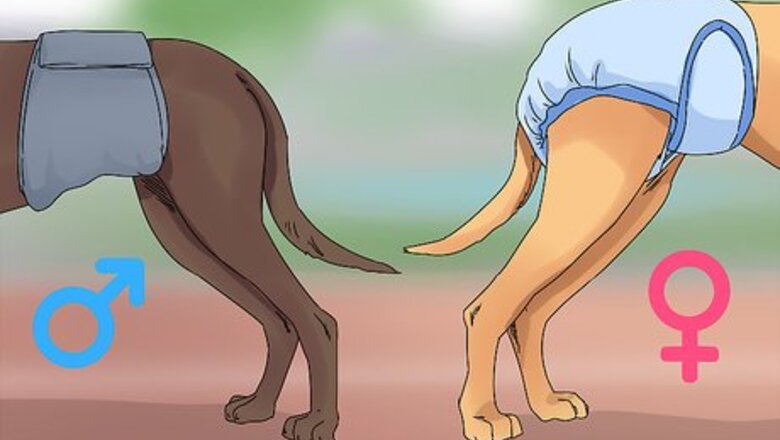
views
Keeping Your Dog Happy and Healthy
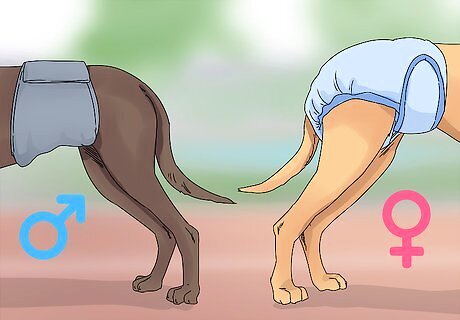
Provide diapers to maintain cleanliness and prevent over-grooming. Dogs clean themselves while they’re in heat, but constant licking can lead to irritation. Outfitting your dog with diapers can help prevent this and keep your home clean. Change the diaper every 2 to 3 hours, or whenever it’s soiled, and cleanse the area with pet wipes to prevent irritation and infection. Look for dog diapers online or at pet stores. Choose a product labeled for your dog’s size and weight, read the instructions, and place it on your dog as directed. Offer plenty of treats and praise as you put on the diaper to encourage your dog to accept it.Tip: Both washable and disposable options are available. While washing reusable diapers may be inconvenient, they’re more environmentally friendly. In the long run, they’re also much less expensive than disposable diapers.

Close off hard-to-clean areas of your home, such as carpeted rooms. If your dog is in heat, it could have bloody discharge at the start and end of when it’s in heat. Put up baby gates or close doors to rooms with upholstered furniture, carpets, and other hard-to-clean surfaces to prevent any stains. While it’s experiencing discharge, keep your dog in areas with hard floors and few soft surfaces. As for your dog’s bed, it’s a good idea to cover it with a machine washable, waterproof lining. Preventing the frustration of accidental messes will help keep both you and dog happy.

Enrich your dog's environment to help manage boredom. Your dog will probably spend more time indoors while it's in heat, so take extra steps to keep it entertained. Set aside extra time to play together and offer stimulating puzzle toys to keep it occupied. Give your pooch plenty of affection, but be sure to give it space if it's resting or doesn't feel like playing. Female dogs in heat tend to get agitated easily. Offering new toys and playing together can help keep your dog entertained and prevent roaming.

Bathe your dog about once a week if bleeding and discharge are heavy. Dogs in heat tend to be anxious or irritable, so offer plenty of praise and treats while you bathe your pet. Wet it down with lukewarm water, lather its fur with shampoo labeled for dogs, and carefully wipe blood and discharge from its hindquarters with a washcloth. Rinse it thoroughly, then gently dry it with a towel. If your dog tolerates it, use a blow dryer on a low, cool setting to speed up the process. Try not to bathe your dog more than once a week. It’s a good idea to apply conditioner to prevent skin irritation, especially if you’re bathing your pet more frequently than normal. In between baths, gently clean its genitals and hindquarters with alcohol-free pet wipes. If blood and discharge are minimal, you may be able to stick to the normal bathing routine and simply use wipes to keep it clean.
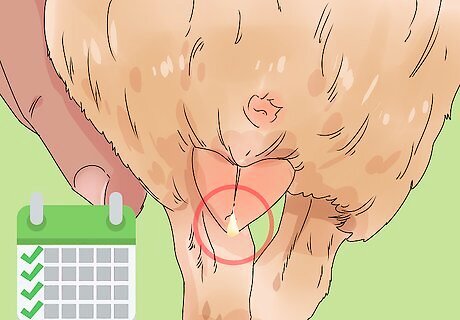
Look for decreased bleeding and swelling within 2 to 4 weeks. Monitor your dog’s genitals and discharge during the course of its cycle. A dog is usually in heat for 3-4 weeks, and your dog will produce discharge for 7-10 days at the beginning and end of the cycle. Watch for the discharge to become gradually lighter in color until it stops altogether. While discharge and enlarged external genitals usually subside within 4 weeks, the cycle may take at least 6 weeks in some dogs. Your dog ovulates in the middle of the heat cycle so it won’t produce as much discharge, if any at all. Even though it may seem like the heat cycle is over during this middle period, keep your dog in a closed-off area in case it starts discharging again. Call the vet if bleeding or discharge don’t start to improve, or if you notice a foul odor or color other than brown or red. When a female dog is in heat, the external part of its genitals, or the vulva, becomes enlarged. Call the vet if you see body parts with slick, shiny surfaces protruding from the vulva. That may be a sign of medical conditions a vet should examine.
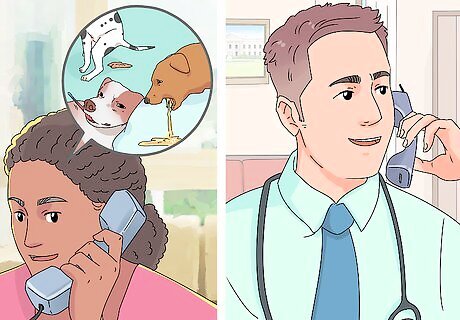
Call the vet if you notice vomiting, diarrhea, or fever. Often enough, stomach upset in dogs subsides quickly and isn’t a major cause for concern. However, schedule a vet appointment promptly if your dog experiences vomiting, diarrhea, fever, lethargy, disinterest, or any other unusual symptoms 4 to 8 weeks after it’s finished its cycle. These symptoms may be signs of pyometra, or infection of the uterus. It requires prompt veterinary care and is typically treated by removing the uterus and other reproductive organs. Pyometra usually occurs within 4 to 8 weeks after the heat cycle ends, but keep in mind it can develop at any point in the heat cycle. If your dog appears to be in heat at an unexpected time, it could also be a symptom of pyometra.
Protecting Your Dog While It’s in Heat
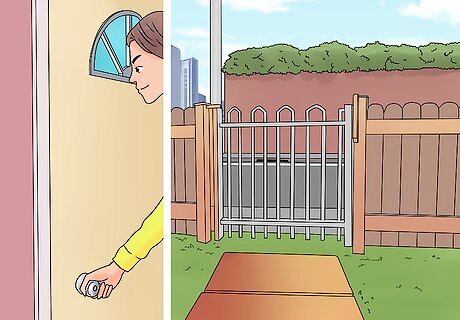
Shut windows, doors, and gates to prevent roaming. To prevent your dog from escaping, make sure all entry points to your home and yard are closed at all times. Dogs in heat often instinctively roam in search of mates. Keeping your gates closed can also help prevent wandering stray males from entering your yard.
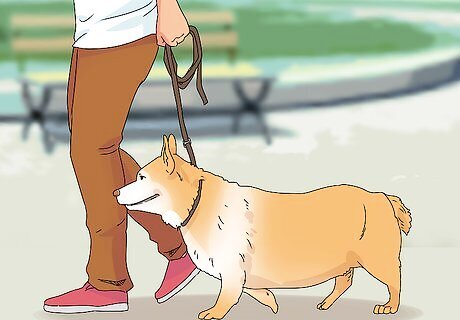
Keep your dog leashed when you go outside. Stay on the safe side and don’t let your dog off of its leash, even if you have a fenced-in yard. Supervise your dog at all times when you're outside. Intact male dogs, or males that haven't been neutered, can sense a female in heat up to 5 miles away. Keeping your pet away from roaming males will help keep it safe and prevent unwanted pregnancy.
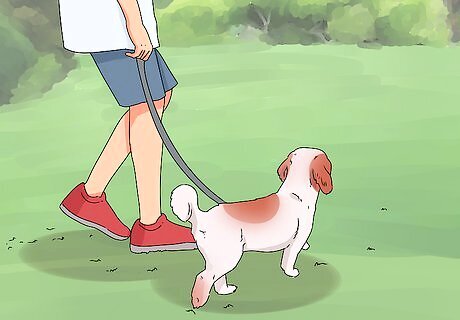
Walk your dog in areas that aren’t frequented by other dogs. Since intact males will be on the lookout for your dog, take precautions when you go on walks and potty breaks. While its in heat, steer clear of any areas where you’ve run into other dogs in the past. Consider letting your dog out to potty only in your fenced-in yard, if you have one. Additionally, don’t bring your pet to dog parks or other places where it could encounter male dogs that haven't been neutered. Avoid unneutered male dogs even if they’re leashed and with their owner.Tip: Since female dogs can be anxious or irritable while they’re in heat, your best bet is to just avoid dogs and other animals altogether until your pet is no longer in heat.
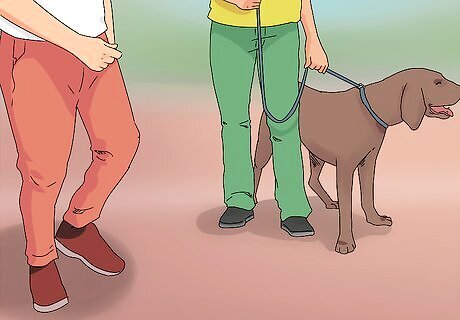
Ask a friend or relative to watch your male dog if you have one. Even if your intact male is related to your dog that’s in heat, keep them separate. If you don’t have a loved one who can dogsit your male for around 2 to 4 weeks, look into boarding it. If that’s not an option, do your best to keep your dogs out of contact until your female is no longer in heat. It might seem like a lot of work, but it’s crucial to protect your female dog while it’s in heat. Dealing with an unwanted pregnancy is a lot of work, and fighting with other dogs, whether male or female, is a bigger risk while it's in heat.
Managing Problematic Behavior

Keep your dog’s environment calm to prevent agitation. Behavioral changes are normal during the heat cycle, but you can take steps to keep anxiety and irritability to a minimum. Do your best to keep your dog away from stressors, such as loud noises, small children, and other animals. A little extra attention will go a long way. To reassure your pet, offer praise in a calm, soothing voice. Spend extra time gently brushing its coat, scratch around its ears, and give a fun new toy or a comfy new bed.
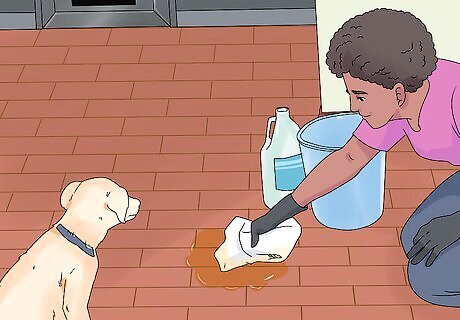
Clean up accidents promptly to prevent marking. While urine marking is typically more of a problem in male dogs, female dogs tend to take up the habit when they’re in heat. The best way to prevent marking is to immediately clean any accident spots with an enzymatic pet odor cleaner. Dogs instinctively mark spots that already carry a scent. If you remove accident odors, your pet will be less tempted to mark indoors. If your dog does attempt to mark, immediately stop it and say “No!” or “Eh-eh!” Then take it outside to relieve itself.Tip: Never punish a dog for indoor accidents after the fact. Dogs can’t understand that a punishment in the present is for something they did in the past.

Redirect your dog if it tries to mount. While you might associate this behavior with male dogs, female dogs commonly mount while they’re in heat. If your dog mounts you, a guest, or another animal, immediately say “No!” and remove it from whomever or whatever it’s mounting. To redirect your dog's attention, grab a treat or toy and command it to sit. Offer the reward as soon as it sits, then practice sitting, lying down, shaking, and any other tricks it knows. In combination, immediately stopping the behavior and redirecting your dog’s attention should discourage mounting.
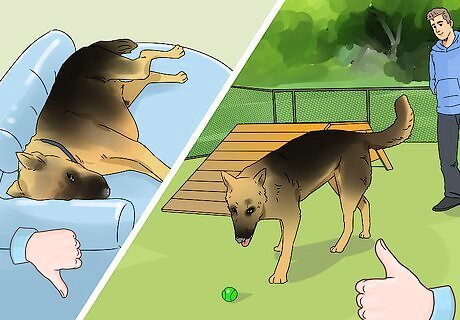
Discourage nesting behavior due to pseudopregnancy, if necessary. Sometimes, female dogs that aren’t allowed to mate experience strong maternal instincts after a heat cycle. They may lactate (produce milk) and try to nurse a “litter” of rolled socks, stuffed animals, and other collected objects. Redirect your pet immediately as soon as you notice any nesting behavior. Take away the collected objects and do a fun activity together. Keep your pet busy with lots of play time, treat-dispensing puzzle toys, and off-leash time in your yard (provided your yard is fenced and its heat cycle is over). If your dog is lactating, its vet can give it medication to stop milk production. Consult the vet or a certified animal behaviorist if nesting behavior persists.




















Comments
0 comment